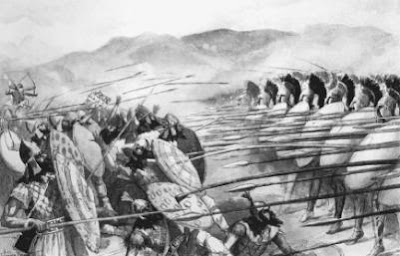The Greco-Persian Wars were the two armed conflicts between the Greek independent city-States, led by Athens and Sparta, and the Persian Empire, at the beginning of the 5th century BC. Their direct causes were the two Persian invasions of Greece, with the first one taking place in 490 BC and the second one in 480 BC. Although the Persian kings Darius I and his son Xerxes I led powerful armies, many times larger in number than the Greek forces, the highly-trained Hellenic infantry proved to be superior on the battlefield, defeating the Persians in a series of decisive battles.
Reason/rationale for the Persian Invasions
The Greek city-States of Athens, Sparta, and Eretria had militarily helped the coastal Greek cities on Asia Minor (Anatolia); today’s Turkey. These cities had been independent for a long time but they had finally been subjugated by the Persians. Thus, they rose up in a violent and large armed rebellion against Cyrus II, the king of the empire of the east (grand father of Darius I). As a retribution for having aided these coastal cities, and in order to expand westwards, Darius I decided to invade ancient Greece.
Summary
First Invasion– In 490 BC, Darius I sent a large fleet, under Artaphernes, to conquer Greece and punish Athens. Having sailed across the Aegean Sea, the Persians besieged and destroyed Eretria. Next, they set sail in a southwest direction, anchoring off the coast of Marathon, which lies about 40 km northeast of Athens. There, about 30,000 Persian soldiers landed on the coast to face off against 8,500 Greek hoplites. As soon as Darius’ forces fell into formation, the Greek phalanxes advanced quickly, then sprinted, attacking the Persian lines, which soon broke up; the Battle of Marathon was the most important battle of the First Greco-Presian War. Seeing that his army was enough to defeat the Greeks, Darius decided to return to Persia.
Second Invasion– Although Darius I died in 486 BC, without being able to return and punish the Greeks, in 480 BC, his son Xerxes I organized a big army and marched on Greece, determined to avenge his father’s defeat. Faced with total annihilation, the Greek city-States got organized and got ready to fight as they created a strong fleet under Themistocles.
In order to give Athenians time to organize their fleet and coastal defenses, the Spartan king Leonidas advanced northwards, leading a small army of hoplites, about 300 men, towards a narrow mountain pass known as the Thermopylae, about 100 km north of Athens. There, the 300 Spartans, plus 500 men from Thebes, delayed the advance of a 120,000-men Persian Army for several days. In such a narrow land corridor, the massive army of Xerxes I was unable to maneuver around and outflank the Spartans, whom they had fight in frontal attacks, for which the Spartan hoplites had been highly trained all their lives.
Having defeated the Spartans at the Battle of Thermopylae, Xerxes marched on Athens, which was attacked, looted, and burned. However, he did not know what was waiting for him. Nevertheless, the large Persian Armada, under Achaemenes, would be thoroughly defeated at the Battle of Salamis at the end of 480 BC by the Athenian efficient fleet in the straits of the island of Salamis and mainland Greece. The following year, in order to finish off the Greeks, the Persian General Mardonius marched on Plataea in 479 BC. There a mixed army composed of Spartans, Athenians, and Thebesians defeated the powerful Persian Army at the Battle of Plataea in the Spring of 479 BC.
Fear of another invasion from Persia led Athens to organize the Delian League to protect the Greek island States of the eastern Aegean Sea. Thus, in 466 BC, the Greeks won the Battle of Eurymedon, liberating these Greeks from Persia.
Below, map of ancient Greece, exhibiting the city-States and the Thermopylae.
The Greek army defeating the Persian forces at the Battle of Plataea in 479 BC.


0 $type={blogger}:
Post a Comment